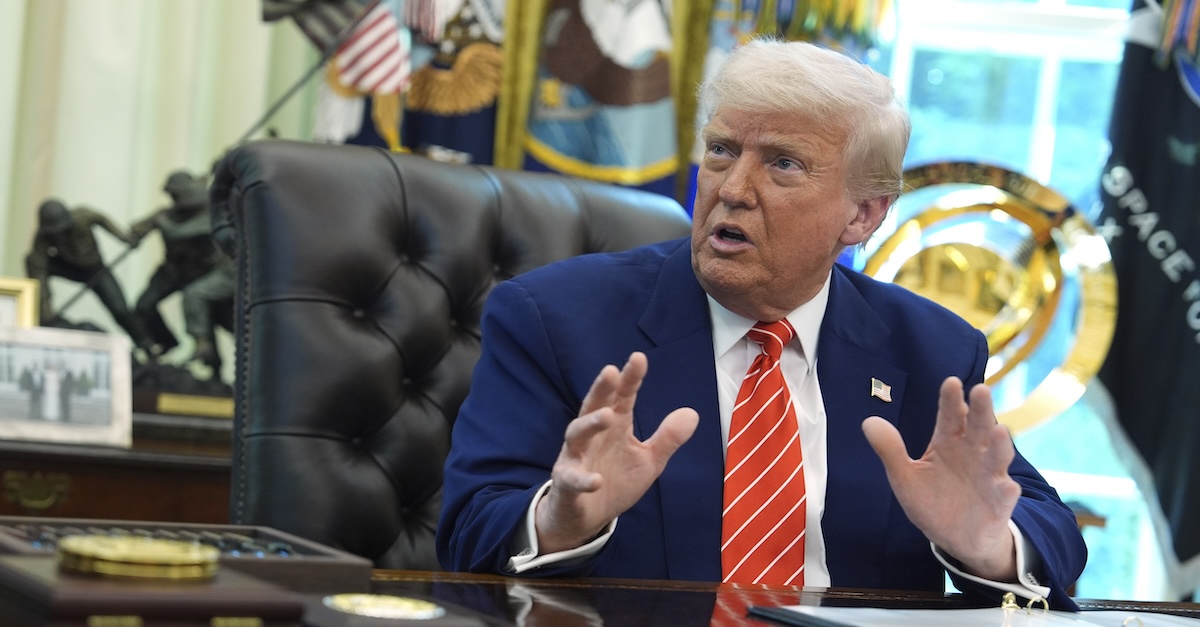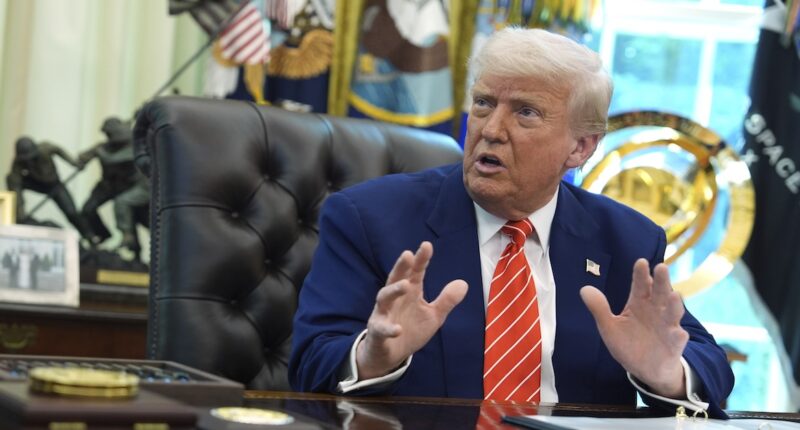
President Donald Trump speaks during a news conference with Elon Musk in the Oval Office of the White House, Friday, May 30, 2025, in Washington (AP Photo/Evan Vucci).
The Trump administration is once again asking the U.S. Supreme Court to lift an injunction issued by a federal court in California and allow the president to move forward with plans to dismantle much of the federal workforce through agency reorganization and mass terminations.
Monday’s emergency filing is the second time the Department of Justice has petitioned the high court in the case. The administration first asked the justices to intervene on May 16, after U.S. District Judge Susan Illston granted the plaintiffs’ request for a temporary a restraining order halting the firings. That filing was withdrawn when the injunction expired after two weeks.
Illston subsequently issued a preliminary injunction which a three-judge panel on the San Francisco-based 9th U.S. Circuit Court of Appeals refused to stay in a 2-1 vote on Friday.
U.S. Solicitor General D. John Sauer excoriated Illston’s order in the petition to the justices, arguing that her injunction “rests on the indefensible premise that the President needs explicit statutory authorization from Congress to exercise his core Article II authority to superintend the internal personnel decisions of the Executive Branch.”
“Controlling the personnel of federal agencies lies at the heartland of this authority,” the filing states. “The Constitution does not erect a presumption against presidential control of agency staffing, and the President does not need special permission from Congress to exercise core Article II powers. The district court’s injunction violates these bedrock principles and other well-established doctrines.”
Love true crime? Sign up for our newsletter, The Law&Crime Docket, to get the latest real-life crime stories delivered right to your inbox.
On Feb. 11, President Donald Trump issued an executive order entitled “Implementing The President’s ‘Department Of Government Efficiency’ Workforce Optimization Initiative.” The order purported to “commence” a “critical transformation of the Federal bureaucracy” by “eliminating waste, bloat, and insularity.”
In a 115-page complaint, the plaintiffs alleged various separations of powers violations, arguing Trump’s order unconstitutionally oversteps into areas reserved for Congress. The complaint also alleged numerous violations of the Administrative Procedure Act (APA), the broad statute governing agency actions.
As Law&Crime previously reported, Trump’s plans would have had administrative agency heads quickly begin initiating “large-scale reductions in force” (RIFs), or massive layoffs, in service of the goal to restructure the government.
Illston pumped the brakes on those efforts.
The lower court reasoned the three agencies principally tasked with the firings and reorganization — the Office of Personnel Management (OPM), the Office of Management and Budget (OMB), and the Department of Government Efficiency (DOGE) — simply lacked the requisite statutory authority to carry out such tasks.
“In sum, no statute gives OPM, OMB, or DOGE the authority to direct other federal agencies to engage in large-scale terminations, restructuring, or elimination of itself,” Illston wrote in the May order. “Such action is far outside the bounds of any authority that Congress vested in OPM or OMB, and, as noted, DOGE has no statutory authority whatsoever.”
The appeals court echoed the district court’s findings on the authority of the three agencies tasked with the reorganization plans — finding each agency acted beyond its statutory authority.
“As Defendants concede, OMB and OPM have only supervisory authority over the other federal agencies,” the order stated. “DOGE has no statutory authority whatsoever. We therefore agree with the district court that these organizations’ actions directing other federal agencies to engage in restructuring and large-scale RIFs were ultra vires.”
“That includes the power to effectuate policy objectives by directing agencies to exercise their statutory authority to conduct RIFs, subject to the guidance of OPM and OMB, so long as it is done in a manner that is fully consistent with law,” Sauer wrote. “The district court turned the constitutional structure upside down by treating as supposed ‘evidence’ of ‘unlawful action’ the mere prospect that ‘agencies are acting at the direction of the President and his team.””
The administration also argued it was “meritless” for the district court to assert that Trump, as president, cannot “fundamentally reorganize” federal agencies with out the express consent of Congress, emphasizing that federal bureaucrats were never intended to become “a class with lifetime employment, whether there was work for them to do or not.”
Justice Elena Kagan, who handles emergency petitions out of the 9th Circuit, ordered the plaintiffs in the case to respond by June 9, 2025.











